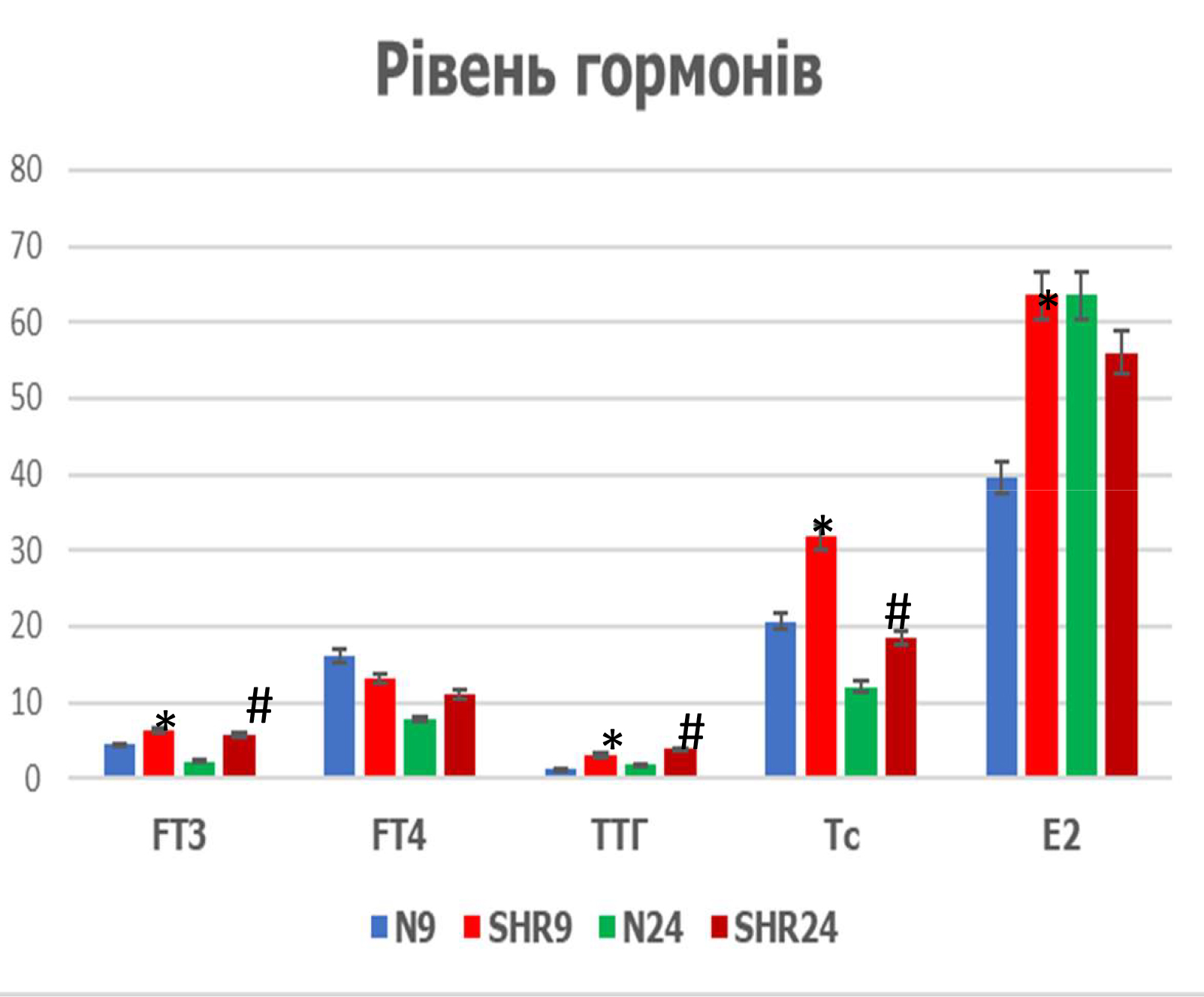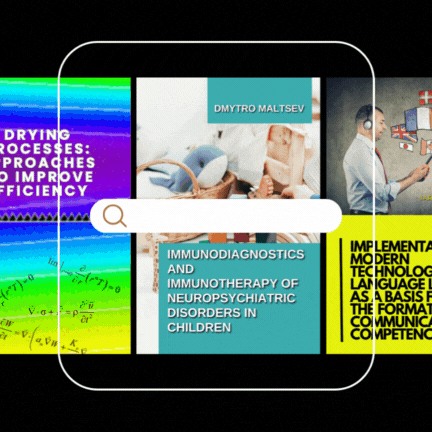Features of age-related changes in thyroid and sex hormones levels in spontaneously hypertensive rats
DOI:
https://doi.org/10.15587/2519-4798.2025.329568Keywords:
arterial hypertension, thyroid hormones, sex hormones, spontaneously hypertensive ratsAbstract
The course of development and progression of arterial hypertension (AH) is influenced by many factors, including the functional state of the endocrine system.
The aim of the study is to determine the content of thyrotropin, free forms of thyroid hormones, total testosterone and estradiol in the blood serum of spontaneously hypertensive rats of the SHR line of different age groups.
Materials and methods. The studies were performed on male rats aged 9 and 24 months. All animal experiments were performed in accordance with the guidelines of the EU Directive 2010/63/EU on the protection of animals used for scientific purposes. White outbred rats served as normotensive controls, and spontaneously hypertensive rats of the SHR line served as a classical model of hypertension. The study of the content of thyrotropin, free forms of thyroid hormones, total testosterone and estradiol was carried out on a microplate enzyme immunoassay analyzer "Stat Fax 3200" (Awareness Technology inc., USA) using standard commercial test kits from the company "Hema" (Ukraine).
Results. The levels of pituitary thyroid-stimulating hormone, free triiodothyronine and total testosterone were significantly higher in SHR rats of both age groups compared to age-matched controls. The level of free thyroxine remained unchanged in all groups. The level of estradiol in the serum of spontaneously hypertensive rats was significantly higher (by 60%) than that of normotensive rats.
Conclusions. SHR rats aged 9 and 24 months are characterized by neuroendocrine features in the form of subclinical hypothyroidism, significantly increased levels of free triiodothyronine and total testosterone, which may affect the premature development of cardiovascular diseases. The level of estradiol was significantly higher only in 9-month-old SHR rats, which may explain the protective effect of these hormones on the state of the cardiovascular system of young rats with hypertension.
References
- Moroz, D. M. et al. (2016). Problemy zdorovia i medychnoi dopomohy ta model pokrashchennia v suchasnykh umovakh. Kyiv: DRUKARNIa «HORDON», 261. Available at: https://library.gov.ua/problemy-zdorovya-medychnoyi-dopomogy-ta-model-pokrashhannya-v-suchasnyh-umovah/
- Sirenko, Yu. M. (2014). Medical and social problems of cardiac care in Ukraine: metods of a solutions. Problemy bezperervnoi med. osvity ta nauky, 2, 6–10. Available at: http://nbuv.gov.ua/UJRN/Psmno_2014_2_3
- Koval, S. M., Rieznik, L. A., Starchenko, T. G. (2023). Characteristics of arterial hypertension in patients after being in a combat zone in the Kharkiv region of Ukraine. Ukrainian Therapeutical Journal, 3, 5–12. https://doi.org/10.30978/utj2023-3-5
- Yamakawa, H., Kato, T. S., Noh, J. Y., Yuasa, S., Kawamura, A., Fukuda, K., Aizawa, Y. (2021). Thyroid Hormone Plays an Important Role in Cardiac Function: From Bench to Bedside. Frontiers in Physiology, 12. https://doi.org/10.3389/fphys.2021.606931
- Kjaergaard, A. D., Marouli, E., Papadopoulou, A., Deloukas, P., Kuś, A., Sterenborg, R. et al. (2021). Thyroid function, sex hormones and sexual function: a Mendelian randomization study. European Journal of Epidemiology, 36 (3), 335–344. https://doi.org/10.1007/s10654-021-00721-z
- Lerman, L. O., Kurtz, T. W., Touyz, R. M., Ellison, D. H., Chade, A. R., Crowley, S. D. et al. (2019). Animal Models of Hypertension: A Scientific Statement From the American Heart Association. Hypertension, 73 (6), e87–e120. https://doi.org/10.1161/hyp.0000000000000090
- Bruhn, T. O., Jackson, I. M. D. (1992). Abnormalities of the thyroid hormone negative feedback regulation of TSH secretion in spontaneously hypertensive rats. Regulatory Peptides, 38 (3), 221–230. https://doi.org/10.1016/0167-0115(92)90104-3
- Kandybko, I. V., Babiychuk, V. G., Babiychuk, L. V., Kudokotseva, O. V., Lomakin, I. I. (2025). Age-based changes in structure and functions of the spontaneously hypertensive rats’ heart. Medicine Today and Tomorrow, 94 (1). https://doi.org/10.35339/msz.2025.94.1.kbb
- Weisser-Thomas, J., Nguyen, Q., Schuettel, M., Thomas, D., Dreiner, U., Grohé, C., Meyer, R. (2007). Age and hypertrophy related changes in contractile post-rest behavior and action potential properties in isolated rat myocytes. AGE, 29 (4), 205–217. https://doi.org/10.1007/s11357-007-9040-1
- Atramentova, L. A., Utevskaia, O. M. (2008). Statisticheskie metodi v biologii. Gorlovka: ChP «VIDAVNITcTVO LІKhTAR», 248. Available at: https://dokumen.pub/978-966-2129-26-7.html
- Mallya, M., Ogilvy-Stuart, A. L. (2018). Thyrotropic hormones. Best Practice & Research Clinical Endocrinology & Metabolism, 32 (1), 17–25. https://doi.org/10.1016/j.beem.2017.10.006
- Vavřínová, A., Behuliak, M., Vodička, M., Bencze, M., Ergang, P., Vaněčková, I., Zicha, J. (2024). More efficient adaptation of cardiovascular response to repeated restraint in spontaneously hypertensive rats: the role of autonomic nervous system. Hypertension Research, 47 (9), 2377–2392. https://doi.org/10.1038/s41440-024-01765-w
- Machado, N. R., Miyazaki, M. A., Oliveira, T. D., Dias, K. T., Colli, L. G., Belardin, L. B. et al. (2024). Systemic alpha-1 adrenergic receptor inhibition reduces sperm damage in adult and aging spontaneously hypertensive rats. Scientific Reports, 14 (1). https://doi.org/10.1038/s41598-024-77661-7
- Loh, S., Salleh, N. (2017). Influence of testosterone on mean arterial pressure: A physiological study in male and female normotensive WKY and hypertensive SHR rats. Physiology International, 104 (1), 25–34. https://doi.org/10.1556/2060.104.2017.1.3
- Iorga, A., Cunningham, C. M., Moazeni, S., Ruffenach, G., Umar, S., Eghbali, M. (2017). The protective role of estrogen and estrogen receptors in cardiovascular disease and the controversial use of estrogen therapy. Biology of Sex Differences, 8 (1). https://doi.org/10.1186/s13293-017-0152-8
- Teoh, H., Quan, A., Leung, S. W. S., Man, R. Y. K. (2000). Differential effects of 17β‐estradiol and testosterone on the contractile responses of porcine coronary arteries. British Journal of Pharmacology, 129 (7), 1301–1308. https://doi.org/10.1038/sj.bjp.0703164
- Reckelhoff, J. F., Zhang, H., Granger, J. P. (1998). Testosterone Exacerbates Hypertension and Reduces Pressure-Natriuresis in Male Spontaneously Hypertensive Rats. Hypertension, 31 (1), 435–439. https://doi.org/10.1161/01.hyp.31.1.435
- Dickey, C., Toot, J., Terwilliger, M., Payne, R., Turner, M., Ely, D. (2012). The SHR Y chromosome increases cardiovascular, endocrine, and behavioral responses to stress compared to the WKY Y chromosome. Physiology & Behavior, 106 (2), 101–108. https://doi.org/10.1016/j.physbeh.2012.01.009
- Stice, J. P., Lee, J. S., Pechenino, A. S., Knowlton, A. A. (2009). Estrogen, aging and the cardiovascular system. Future Cardiol., Jan, 5 (1), 93–103. https://doi.org/ 10.2217/14796678.5.1.93.
- Faustino, L. C., Gagnidze, K., Ortiga-Carvalho, T. M., Pfaff, D. W. (2015). Impact of Thyroid Hormones on Estrogen Receptor α-Dependent Transcriptional Mechanisms in Ventromedial Hypothalamus and Preoptic Area. Neuroendocrinology, 101 (4), 331–346. https://doi.org/10.1159/000381459

Downloads
Published
How to Cite
Issue
Section
License
Copyright (c) 2025 Igor Kandybko

This work is licensed under a Creative Commons Attribution 4.0 International License.
Our journal abides by the Creative Commons CC BY copyright rights and permissions for open access journals.
Authors, who are published in this journal, agree to the following conditions:
1. The authors reserve the right to authorship of the work and pass the first publication right of this work to the journal under the terms of a Creative Commons CC BY, which allows others to freely distribute the published research with the obligatory reference to the authors of the original work and the first publication of the work in this journal.
2. The authors have the right to conclude separate supplement agreements that relate to non-exclusive work distribution in the form in which it has been published by the journal (for example, to upload the work to the online storage of the journal or publish it as part of a monograph), provided that the reference to the first publication of the work in this journal is included.








